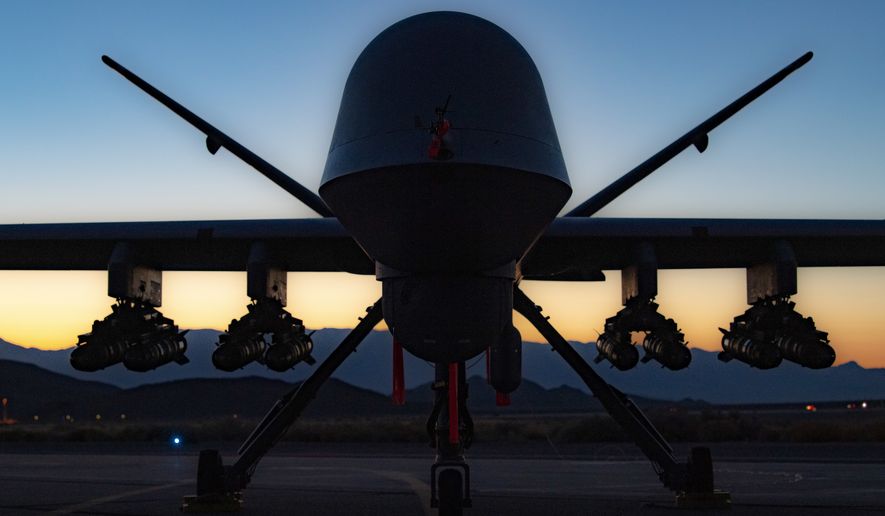In today’s military, it’s not enough anymore just to be able to shoot the guy who is trying to shoot you.
With what military planners call “unmanned aircraft systems” (UAS) — drones — rapidly revolutionizing age-old warfighting theories, the Army wants counter-drone capabilities to be in the toolkit of even the lowliest private on the battlefield.
Every soldier, regardless of assignment, should know how to help knock out swarms of enemy drones before they can wreak havoc on a unit in combat, the head of the Pentagon’s counter-drone effort said this week.
Drones — armed and unarmed, sophisticated or off-the-shelf — represent a “rapidly proliferating, low-cost, high-reward asset” capable of reconnoitering an enemy position or carrying out direct, lethal attacks on U.S. personnel. The Army-led Joint Counter-small Unmanned Aircraft Systems office (C-sUAS) was established to develop a strategy for addressing the growing threat.
“The threat continues to use UAS as [intelligence, surveillance and reconnaissance] platforms,” said Army Maj. Gen. Sean Gainey, director of the Joint Counter Small UAS Office, or JCO.
Some have compared the impact of small and relatively cheap drones to the improvised explosive devices, or IEDs, that have killed and maimed thousands of military members and civilians in Iraq and Afghanistan.
The one-time near-monopoly that the U.S. enjoyed in military drone technology is a thing of the past. Defense analysts the world over are poring over the data from last fall’s brief, bloody war between Azerbaijan and Armenia. The convincing Azeri victory was largely credited to the use of Israeli- and Turkish-made drones that revealed enemy troop and artillery positions to devastating effect.
A counter-drone strategy can’t be focused solely on foreign battlefields. During a briefing this week with Pentagon reporters, Maj. Gen. Gainey said there have been sightings of unmanned aerial systems flying near military installations in the U.S.
“They could be perceived as a threat because you really don’t know the intent of some of them,” he said. “You have to take any incursion as a threat.”
Beginning in April, the Army will play host to defense industry leaders at the Yuma Proving Ground in Arizona. The companies have been invited to demonstrate counter-drone weapon systems such as high-energy lasers and powerful microwaves as a way to defend large units.
But Pentagon planners acknowledge there won’t be enough short-range air defense units to protect everyone on the battlefield. That means developing weapons systems and counter-drone strategies that everyone in a unit — regardless of their assigned job — can master, officials said.
“Anyone from a cook to a medic to an infantryman or tanker can operate the system. We’re trying to make the requirements and material solutions very intuitive,” said Army Col. Marc Pelini, the JCO’s capabilities and requirements division chief.
Gen. Gainey said his office is facing renewed urgency in the search for a counter-drone system suitable for use by the soldier on the front line. It might be an electronic warfare weapon capable of jamming enemy drone signals, he said.
“There’s no concept set in stone right now. We’re creating as we’re moving forward,” he said.
In addition to working with industry to create counter drone weapon systems, the JCO is exploring some kind of formal training academy for operators. Gen. Gainey said they were looking at “several locations” for the Pentagon’s new base, which will ultimately be known as the Joint Counter UAS Center of Excellence.
“We want everybody in the force to have the ability to defeat this threat,” he said.
The Pentagon’s new counter-drone training base is expected to be established by 2024. Non-resident training courses may be suitable for soldiers learning only to employ a particular counter-drone weapon system. But those who need to understand how the different systems interact with each other might require a temporary transfer to the base, officials said.
“We don’t see the counter-UAS problem set as one enduring solution. We see it as a range of capabilities that gives you the ability to assess threats,” Gen. Gainey said.
• Mike Glenn can be reached at mglenn@washingtontimes.com.




Please read our comment policy before commenting.